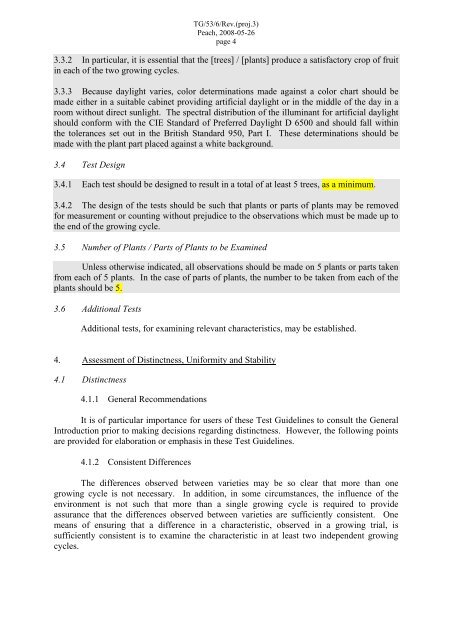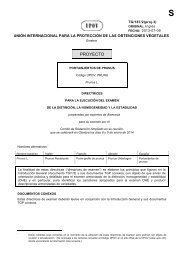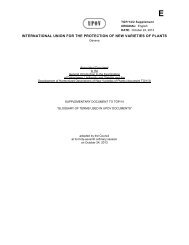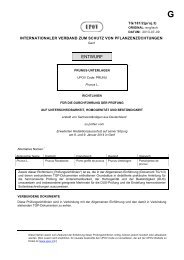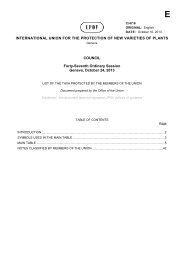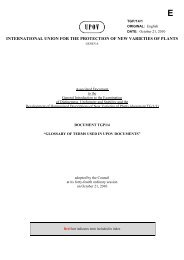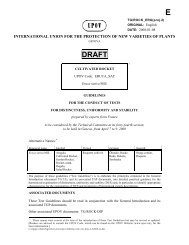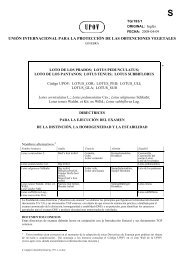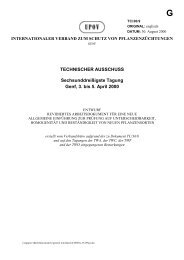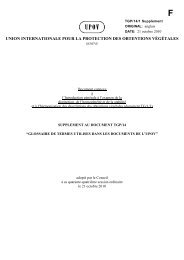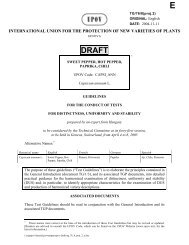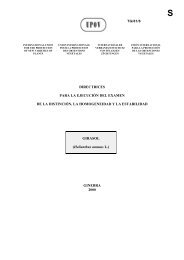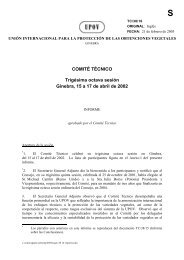draft - International Union for the Protection of New Varieties of Plants
draft - International Union for the Protection of New Varieties of Plants
draft - International Union for the Protection of New Varieties of Plants
Create successful ePaper yourself
Turn your PDF publications into a flip-book with our unique Google optimized e-Paper software.
TG/53/6/Rev.(proj.3)<br />
Peach, 2008-05-26<br />
page 4<br />
3.3.2 In particular, it is essential that <strong>the</strong> [trees] / [plants] produce a satisfactory crop <strong>of</strong> fruit<br />
in each <strong>of</strong> <strong>the</strong> two growing cycles.<br />
3.3.3 Because daylight varies, color determinations made against a color chart should be<br />
made ei<strong>the</strong>r in a suitable cabinet providing artificial daylight or in <strong>the</strong> middle <strong>of</strong> <strong>the</strong> day in a<br />
room without direct sunlight. The spectral distribution <strong>of</strong> <strong>the</strong> illuminant <strong>for</strong> artificial daylight<br />
should con<strong>for</strong>m with <strong>the</strong> CIE Standard <strong>of</strong> Preferred Daylight D 6500 and should fall within<br />
<strong>the</strong> tolerances set out in <strong>the</strong> British Standard 950, Part I. These determinations should be<br />
made with <strong>the</strong> plant part placed against a white background.<br />
3.4 Test Design<br />
3.4.1 Each test should be designed to result in a total <strong>of</strong> at least 5 trees, as a minimum.<br />
3.4.2 The design <strong>of</strong> <strong>the</strong> tests should be such that plants or parts <strong>of</strong> plants may be removed<br />
<strong>for</strong> measurement or counting without prejudice to <strong>the</strong> observations which must be made up to<br />
<strong>the</strong> end <strong>of</strong> <strong>the</strong> growing cycle.<br />
3.5 Number <strong>of</strong> <strong>Plants</strong> / Parts <strong>of</strong> <strong>Plants</strong> to be Examined<br />
Unless o<strong>the</strong>rwise indicated, all observations should be made on 5 plants or parts taken<br />
from each <strong>of</strong> 5 plants. In <strong>the</strong> case <strong>of</strong> parts <strong>of</strong> plants, <strong>the</strong> number to be taken from each <strong>of</strong> <strong>the</strong><br />
plants should be 5.<br />
3.6 Additional Tests<br />
Additional tests, <strong>for</strong> examining relevant characteristics, may be established.<br />
4. Assessment <strong>of</strong> Distinctness, Uni<strong>for</strong>mity and Stability<br />
4.1 Distinctness<br />
4.1.1 General Recommendations<br />
It is <strong>of</strong> particular importance <strong>for</strong> users <strong>of</strong> <strong>the</strong>se Test Guidelines to consult <strong>the</strong> General<br />
Introduction prior to making decisions regarding distinctness. However, <strong>the</strong> following points<br />
are provided <strong>for</strong> elaboration or emphasis in <strong>the</strong>se Test Guidelines.<br />
4.1.2 Consistent Differences<br />
The differences observed between varieties may be so clear that more than one<br />
growing cycle is not necessary. In addition, in some circumstances, <strong>the</strong> influence <strong>of</strong> <strong>the</strong><br />
environment is not such that more than a single growing cycle is required to provide<br />
assurance that <strong>the</strong> differences observed between varieties are sufficiently consistent. One<br />
means <strong>of</strong> ensuring that a difference in a characteristic, observed in a growing trial, is<br />
sufficiently consistent is to examine <strong>the</strong> characteristic in at least two independent growing<br />
cycles.


